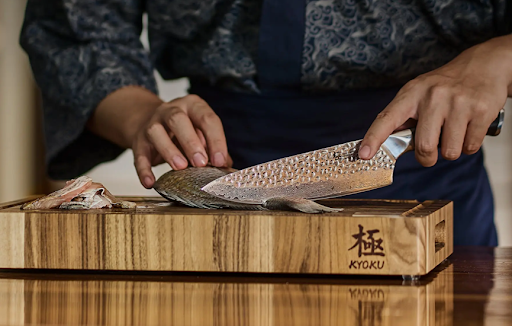There’s something mesmerizing about watching a skilled chef at work — the rhythmic chop of the blade, the neat precision of each slice, and the way ingredients seem to fall apart effortlessly. Behind that grace and control lies one essential tool: a Japanese chef knife. More than just a piece of metal, it’s the perfect balance of artistry, craftsmanship, and performance. In this article, we’ll explore the world of Japanese knives — how they differ from Western blades, how to use them effectively, and how to choose the right one for your kitchen.
The Philosophy Behind Japanese Knives
Japanese knives carry centuries of tradition, tracing their craftsmanship back to the swordsmiths who forged samurai blades. That same dedication to sharpness, balance, and detail is now found in modern kitchen knives.
Unlike heavier Western knives that rely on force, Japanese knives focus on precision and control. They’re typically crafted from high-carbon steel, which holds a razor-sharp edge, and often feature single-bevel edges that allow for cleaner, more delicate cuts. Every curve and angle serves a purpose — a reflection of the Japanese belief that cooking is an art form, not just a task.
Meet the Key Players: Common Japanese Knife Types
Each Japanese knife is designed with intention — tailored for specific ingredients and cutting techniques. Here are some of the most popular ones you’ll find in professional and home kitchens alike:
- Gyuto (Chef’s Knife): The Japanese equivalent of the Western chef’s knife, the Gyuto is a versatile all-rounder perfect for slicing meat, fish, or vegetables. Its thin, curved blade allows for smooth rocking motions and effortless precision.
- Santoku: A favorite among home cooks, the Santoku (meaning “three virtues”) excels at slicing, dicing, and mincing. Its shorter, flatter blade makes it ideal for fine chopping and controlled movements.
- Nakiri: Designed specifically for vegetables, the Nakiri’s straight edge creates even slices and thin julienne cuts without crushing delicate produce.
- Yanagiba: A long, slender blade traditionally used for sushi and sashimi. It glides through fish with minimal friction, ensuring clean, smooth cuts that preserve texture and flavor.
- Deba: A thick, sturdy knife made for breaking down fish or poultry. Its robust design gives you the power to cut through small bones while maintaining accuracy.
Whether you’re dicing onions for stir-fry or slicing sashimi for a weekend dinner, having the right knife can make your prep work faster, cleaner, and more enjoyable.
Techniques in Action: Getting the Most from Each Knife
The beauty of a Japanese knife lies not only in its design but in how it’s used.
- Grip and motion: Hold the handle firmly but not tightly, guiding the knife with your fingers while letting the blade do the work.
- Matching knife to ingredient: Use your Santoku for everyday prep — chopping garlic, herbs, and vegetables. Switch to your Nakiri for paper-thin slices of cucumber or carrots. For a special sushi night, the Yanagiba will give you those restaurant-perfect cuts of tuna or salmon.
Remember, a sharp knife is actually safer than a dull one. Sharp blades require less pressure, reducing the risk of slipping. Focus on smooth, deliberate motions — think of it as letting the knife glide, not hack.
Care and Maintenance: Keeping the Edge Alive
A Japanese knife deserves care as fine as its craftsmanship.
- Always hand wash your knives — never toss them in the dishwasher.
- Hone regularly to realign the edge, and sharpen with a whetstone when needed.
- Store them safely on a magnetic strip or in a wooden block to prevent nicks and dulling.
Proper maintenance not only keeps your knives sharp but also preserves their beauty and performance for years. Over time, you’ll find that a well-kept blade cuts cleaner, feels smoother, and brings more joy to every meal.
Choosing the Right Knife for You
Selecting your first Japanese knife can feel overwhelming, but it’s all about matching the tool to your cooking style.
- For everyday versatility: Choose a Gyuto — it can handle almost anything.
- For vegetable lovers: A Nakiri knife will make prep faster and neater.
- For precise slicing or sushi prep: Try a Yanagiba for professional results.
If you’re looking for a well-balanced, beginner-friendly option, consider investing in a Japanese knife set. A good set typically includes a chef’s knife, a paring knife, and a Santoku — giving you flexibility for everything from mincing herbs to slicing meat. Look for features like a high-carbon stainless steel blade, ergonomic handle, and full tang construction for durability and comfort.
Cooking as an Art Form
When you hold a Japanese knife, you’re not just holding a kitchen tool — you’re holding centuries of tradition, innovation, and artistry. Each cut becomes smoother, each meal more enjoyable, and each moment in the kitchen more mindful. So next time you slice into a tomato, dice an onion, or prepare sashimi, take a moment to appreciate the craftsmanship behind your knife. It might just change the way you think about cooking — transforming it from a daily routine into a form of art.









